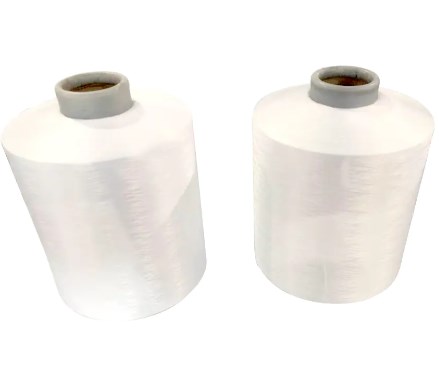Navy/Grey 150D/36F DTY Yarn 99.99% Polyester Anti-pilling Yarn for Sewing Materi...
See DetailsPolyester SD Yarn, a high-quality fiber material that has gained rapid attention in the textile industry in recent years, is gradually becoming an important foundation for the upgrading and functional enhancement of various fabrics. As consumers' demands for comfort, appearance, and textile durability continue to increase, SD technology gives polyester yarn a more natural, delicate, and soft style, making it suitable for home textiles, apparel, industrial fabrics, and many other fields.
Polyester SD Yarn Technical Characteristics
The "SD" in Polyester SD Yarn refers to the special design of the fiber cross-section in the yarn bundle, giving the fiber surface a matte, soft, or even cotton-like texture. This structure allows the yarn to exhibit a more understated and natural sheen after weaving, avoiding the overly bright reflective effect of ordinary polyester yarn. The application of SD yarn is particularly crucial in apparel and home textile fabrics that pursue a high-end feel. The optimized internal fiber structure exhibits better moisture absorption and release characteristics, allowing the fabric to maintain toughness and abrasion resistance while providing a more comfortable, skin-friendly experience.
SD fibers, through adjustments to the spinneret shape and fiber surface microstructure during the spinning stage, possess more random light scattering points, thus creating a natural matte effect. This design not only enhances the fabric's premium feel but also provides greater color uniformity and stability for subsequent dyeing processes. It significantly improves the fabric's refinement, layering, and overall visual softness.

Advantages of Polyester SD Yarn in Textile Manufacturing
Polyester SD Yarn possesses better dye affinity due to its fiber surface texture, resulting in more stable and delicate color presentation in the finished fabric. The color saturation is moderate and not glaring, perfectly matching the aesthetic demands of modern home furnishings and high-end apparel. SD yarn exhibits superior flexibility during weaving, resulting in a smoother fabric surface, reduced stiffness, and improved drape. It also provides more balanced stress adjustment in the warp and weft directions, enhancing the overall stability of the fabric.
Compared to ordinary polyester yarn, the visual and tactile improvements of SD yarn have made it a favorite in numerous manufacturing fields. During processing, the fabric exhibits enhanced pilling resistance and abrasion resistance, significantly extending its lifespan. In home textiles, the natural texture and soft touch of this yarn are often the primary quality characteristics consumers prioritize, which is a key reason why Polyester SD Yarn maintains its competitiveness in the market.
Expanding Applications of Polyester SD Yarn
Polyester SD Yarn is widely used in apparel fabrics, sofa fabrics, curtains, bedding, functional fabrics, and engineered fabrics. Due to its natural surface appearance and soft feel, its use in home décor fabrics is increasing year by year. More and more sofa fabrics, cushion fabrics, and finished curtains are using SD yarn to achieve a more sophisticated matte finish and delicate touch.
In the apparel industry, Polyester SD Yarn is commonly used to make intimate apparel and high-end casual fabrics. In addition to its excellent resilience and wrinkle resistance, this yarn gives the fabric a unique softness, resulting in a more ideal fit when worn. For brands emphasizing fashionable texture and comfortable experience, SD yarn is becoming an important material for enhancing product competitiveness.
In the functional field, the abrasion resistance and stable structure of SD yarn make it suitable for some engineering fabrics, such as outdoor fabrics and filter materials. While maintaining durability and structural stability, its controllable luster avoids strong reflections in outdoor environments, making products more practical and comfortable.
Polyester SD Yarn Drives Textile Texture Upgrades
The core value of Polyester SD Yarn is not only reflected in its visual and tactile performance but also in the overall texture upgrade it brings to textiles. As consumers' pursuit of quality of life continues to increase, textile materials need to be comprehensively improved in terms of design, function, and sensory experience. The emergence of SD yarn perfectly matches this trend, allowing fabrics to achieve a more natural and upscale visual effect and tactile feel through micro-adjustments in structure.
This differentiated fiber not only improves the long-standing impression of polyester as "too stiff and too shiny" but also provides textile companies with more diversified product development ideas, giving designers greater room for expression in shaping fabric styles. The softness and natural feel of polyester yarn allow finished fabrics in home textiles and apparel to exhibit an effect closer to natural fibers, while maintaining polyester's advantages in abrasion resistance, durability, and maintainability.
With continuous technological innovation in the textile industry, polyester SD yarn is evolving towards higher fineness, lower luster, softer texture, and greater environmental friendliness. New environmentally friendly dyeing and finishing technologies and recyclable spinning materials will further optimize SD yarn in green production, meeting market demand for sustainable textiles. Simultaneously, SD yarn is being combined with functional polyester to create multifunctional, integrated yarns with antibacterial, waterproof, and quick-release moisture properties, providing more possibilities for future high-performance fabrics.
The future of polyester SD yarn will not be merely a simple matte yarn, but a comprehensive fiber material combining functionality, aesthetics, and sustainability. It will achieve greater competitiveness in home textiles, apparel, industrial fabrics, and other fields, becoming a powerful tool for textile companies to solidify their market share and enhance product differentiation.